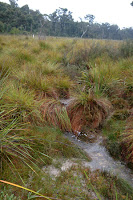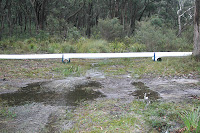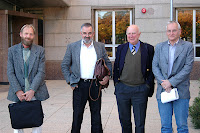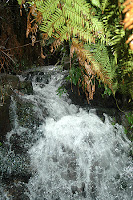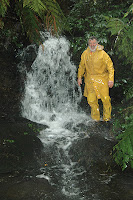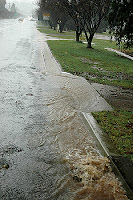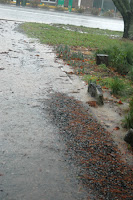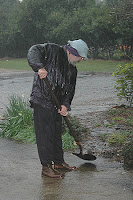behind Pine Tree branches,
moving in a strong wind.
 How many times have I muttered this phrase? - Never leave home without your Camera! But I still do it.
How many times have I muttered this phrase? - Never leave home without your Camera! But I still do it.This morning, I went to volunteer at the local CTC (Community Technology Centre), and that meant I would be leaving the car in the car park. Then I knew I would go to Bowral, to do some supermarket shopping. Nothing to photograph, plus a risk of losing the camera - right? I know Bowral is not the crime capital of the world, but, lets not take a chance. Better to leave it at home?
Wrong!
seen through branches
of a Pine Tree.
 As I drove back from Bowral, past Burrawang to Robertson (due east) the most stunning full moon was rising, against a pale blue afternoon sky, over a line of pink-washed cumulus clouds (out over the coast). Damn it was a pretty sky. And my camera was fifteen minutes away.
As I drove back from Bowral, past Burrawang to Robertson (due east) the most stunning full moon was rising, against a pale blue afternoon sky, over a line of pink-washed cumulus clouds (out over the coast). Damn it was a pretty sky. And my camera was fifteen minutes away.Of course, I realised- too late - that this was one of those "Blue Moon" events.
Astronomers are not impressed with so called "Blue Moons" - they are just a normal full moon, which for reasons of the calendar, not astronomy, have been ascribed this name. The commonly understood term is when there is a second Full Moon occurring within a month. Today, being 30 June, it means that this is the second 28 day cycle in this month. That is all. Wikipedia, boringly says this usage is a mis-interpretation of this term.***
But gosh, it was a beautiful rising Full Moon, in a clear late afternoon sky, against a backdrop of clouds. That was special, for reasons of ephemeral weather conditions, not for astronomical reasons, nor even reasons to do with the calendar.
 These photos of the moon were the best which I could come up with, after I got home. My house is has a high easterly horizon, as I am just below a ridge, with tall pine trees on my neighbour's property.
These photos of the moon were the best which I could come up with, after I got home. My house is has a high easterly horizon, as I am just below a ridge, with tall pine trees on my neighbour's property.So the moon is quite high in the sky before it shines above the trees, into my property. So, the sky is well and truly dark by the time a full moon has risen that far.
So you get a black sky effect here. Still, it was a lovely full moon.
Blue Moon?
 Nope - a tinted one!
Nope - a tinted one!Sorry, I could not resist a little Photoshop experiment.
*** How is this for a belated apology?
Referring to the origin of the commonly used meaning of "Calendar Blue Moons" Wikipedia says:
"This definition of blue moon originated from a mistake in an article in the March 1946 Sky & Telescope magazine, which failed in an attempt to infer the earlier definition used in the original Farmer's Almanac (see above). It was helped to popularity when Deborah Byrd of Earth & Sky walked into the Peridier astronomy library at the University of Texas at Austin one day, leafed through some old magazines, and found the 1948 blue moon article in Sky & Telescope. She used the definition – the second full moon in a single month – in the radio series Star Date for some years. As a result, the game Trivial Pursuit used a question and answer about blue moon.
Sky & Telescope discovered the error nearly sixty years later and the magazine printed a retraction and correction."
On that basis, John Howard has time on his side to apologise to the Aboriginal people, on that calculation!









